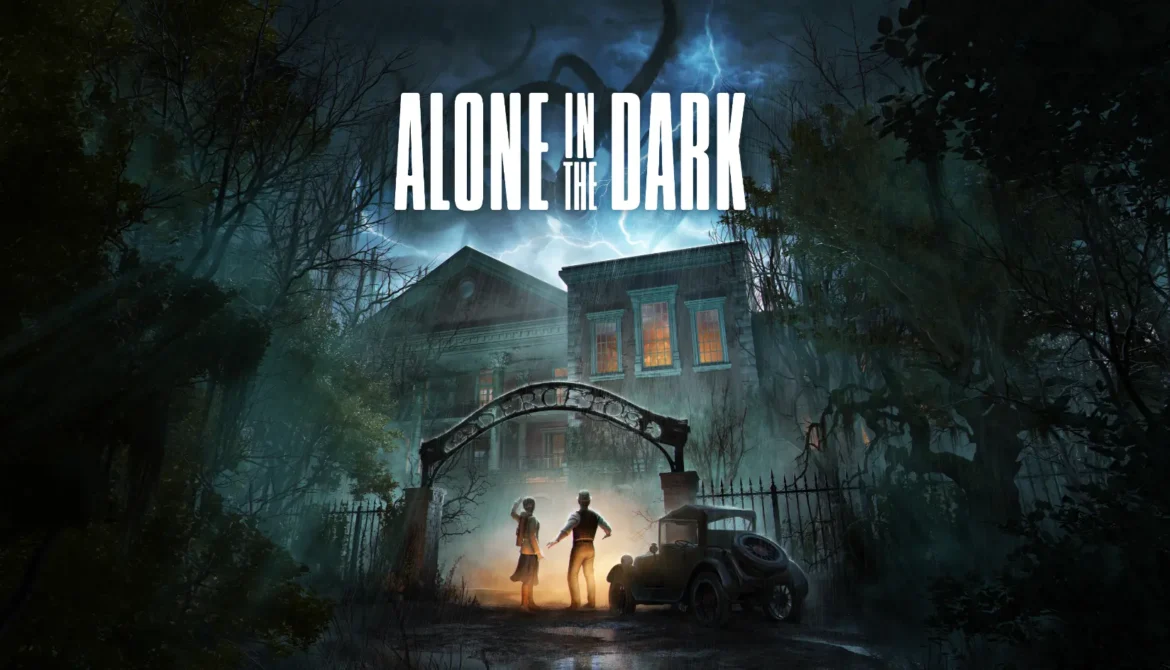Release Date : March 20, 2024
Developer(s) : Pieces Interactive
Publisher(s) : THQ Nordic
Platforms : PS5, Xbox Series X/S, PC
From 1992 to 2015, Alone in the Dark went from a legendary action-adventure game to a dull multiplayer TPS, and experienced both tremendous highs and infernal lows. The evil rooted in some of its episodes has nearly buried the franchise on several occasions. But one thing voodoo has taught us already is that there are forces beyond our nature capable of returning from the darkness more powerful than ever.
So, has Edward Carnby, the strange detective, finally overcome the curses he’s been struggling with for over 30 years? Let’s find out.
Table of Contents
Two Paths, One Nightmare
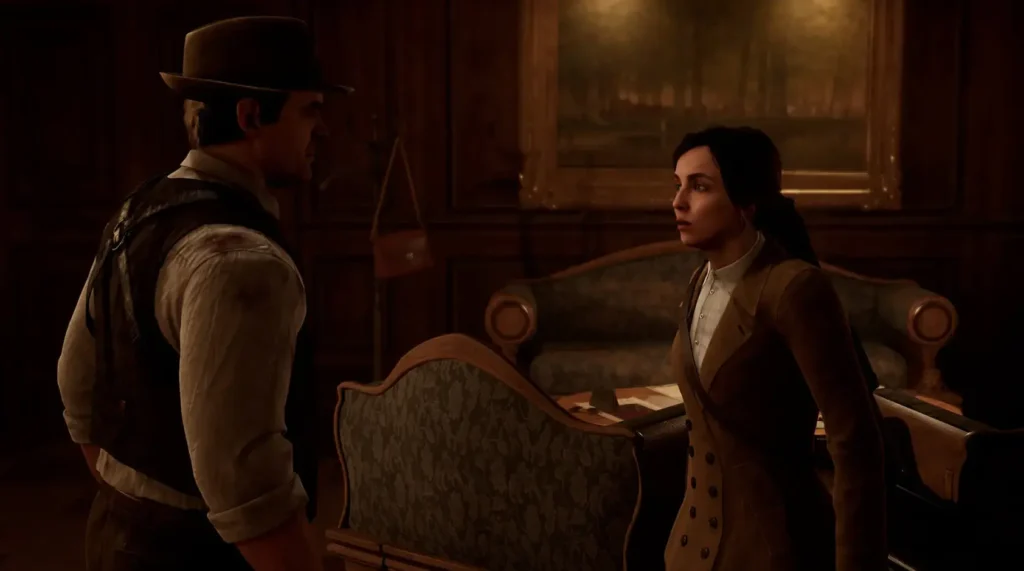
In Louisiana’s muggy shadows, even your eyes will betray you. And your memories will vanish like a puddle in front of a blazing fire, before returning to your brain like a doctor’s ice pick. Forget everything you think you know about Alone in the Dark’s story. While inspired by the events of Frédérick Raynal’s original 1992 game, this production from the Swedish studio Pieces Interactive is neither a remake nor a remaster. Like the swarms of killer mosquitoes swarming the Bayou, the artists hired by THQ Nordic draw their inspiration from the blood of the French icon of Survival Horror.
Just like 32 years ago, we find Edward Carnby and Emily Hartwood trapped in the haunted mansion of Derceto. Except that in this new interpretation of the myth, the two protagonists enter the cursed building together, the young woman having hired the detective’s services to help her solve the mystery surrounding her uncle’s condition. Because yes, Jeremy Hartwood isn’t dead here, even if demons are after him.
The poor fellow, a patient of Dr. Gray’s – whose practice lies within the cramped walls of the imposing mansion – had time to warn his niece that danger lurked. The rest of the adventure is as full of nods to the fans as a child sowing pebbles to avoid getting lost in the forest, with the presence of the talisman, the clock, the piano, and the giant tree (among others) within the scope of an original story officially designed to appeal to both newcomers and veterans.
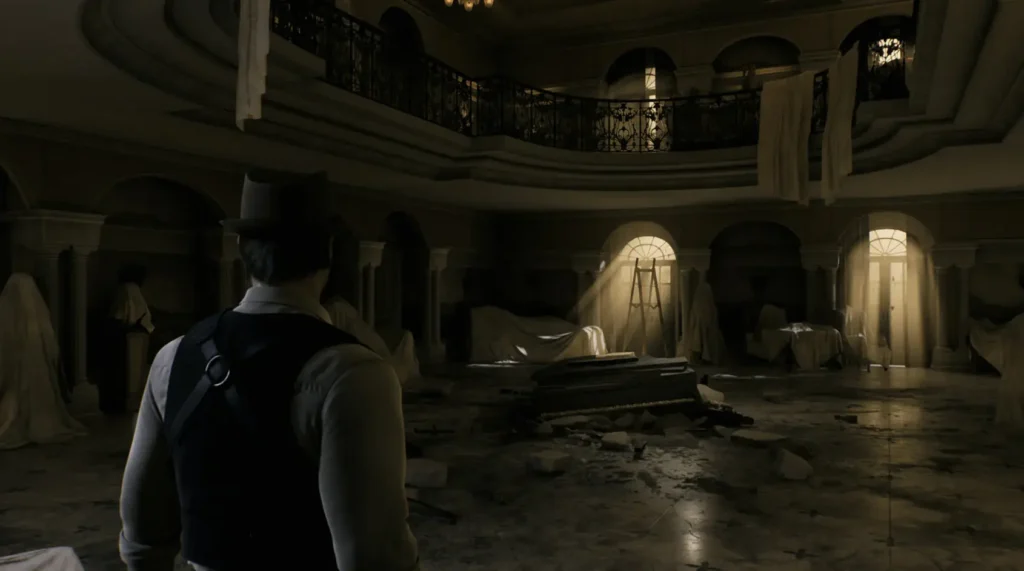

Once the thrilling opening cutscene is over, the player can choose the character they want to control for the next nine hours. The duo splits up at the beginning of the adventure, reuniting only on rare occasions. Two scenarios aren’t enough to understand the twists and turns of this weird story.
Unfortunately, if you’re hoping for two different campaigns like The New Nightmare from 2001, you’ll be disappointed. Except for two or three details, Carnby’s and Hartwood’s paths are identical. Sure, the cutscenes vary and there are a few differences, particularly in the encounters with NPCs, but in the end, there’s only one playable sequence dedicated to both scenarios. In other words, it’s better than 1992, when the two heroes lived the same adventure 100% of the time, but it’s a long way from what the fourth episode delivered.
A Nostalgic Return with Modern Frustrations
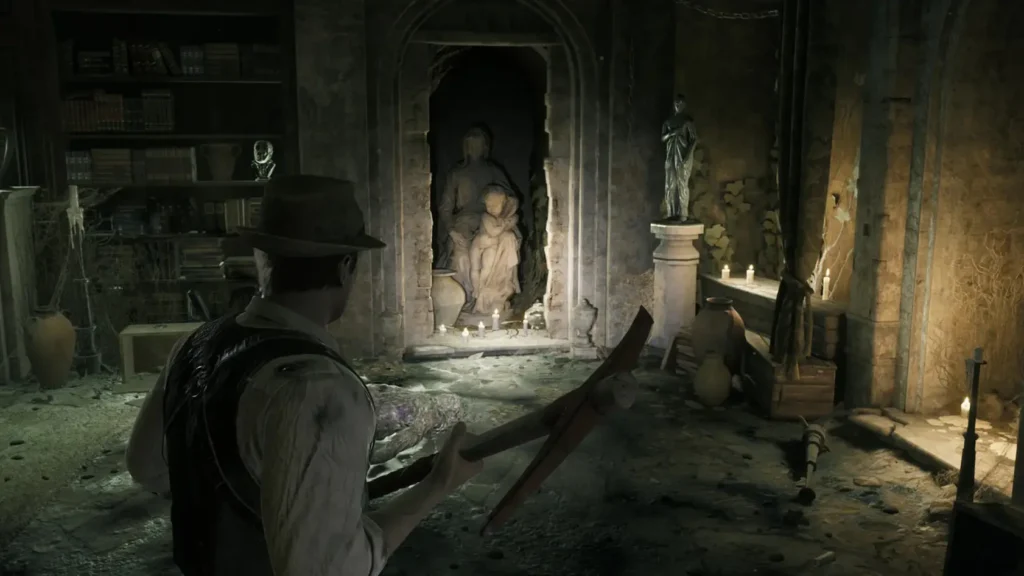
Alone in the Dark 2024 is a third-person action-adventure/ survival-horror game in its purest form, set in a Lovecraftian universe. It requires you to explore linear levels in search of keys, objects, or clues to solve puzzles. Of course, aggressive creatures are also present to enhance the experience. The game uses Derceto as a sort of central HUB where heroes can be sent to particular levels according to the script.
Survival Horror requires frequent back-and-forth trips, with jumpscares – more or less successful – trying to break the routine occasionally. Whereas Frédérick Raynal’s creation took great pleasure in killing us instantly for crossing a corridor too quickly or reading a cursed book without blinking an eye, Pieces Interactive’s production is satisfied with rushing us through sudden teleportations inside alternative versions of the places we visit with an effective, if not radical, result.
More action-oriented than the 1992 title, but without becoming a vicious TPS, Alone in the Dark offers us three guns (pistol, shotgun, submachine gun) as well as various hand-to-hand weapons to help send the infernal monsters back to where they came from. Very similar to Resident Evil 3 remake in its gameplay, with the ability to dodge hits, the game is limited by some arguable design choices.
Like the latest Silent Hill, melee weapons are destructible, and unlike Resident Evil, projectiles cannot be stored. And something that was a real plus in Eden’s 2008 installment of the series – crafting Molotov cocktails with multiple effects – is basically a sketchy contextual element here. The bricks and bottles you find have to be thrown away in the next few moments, or forget it.
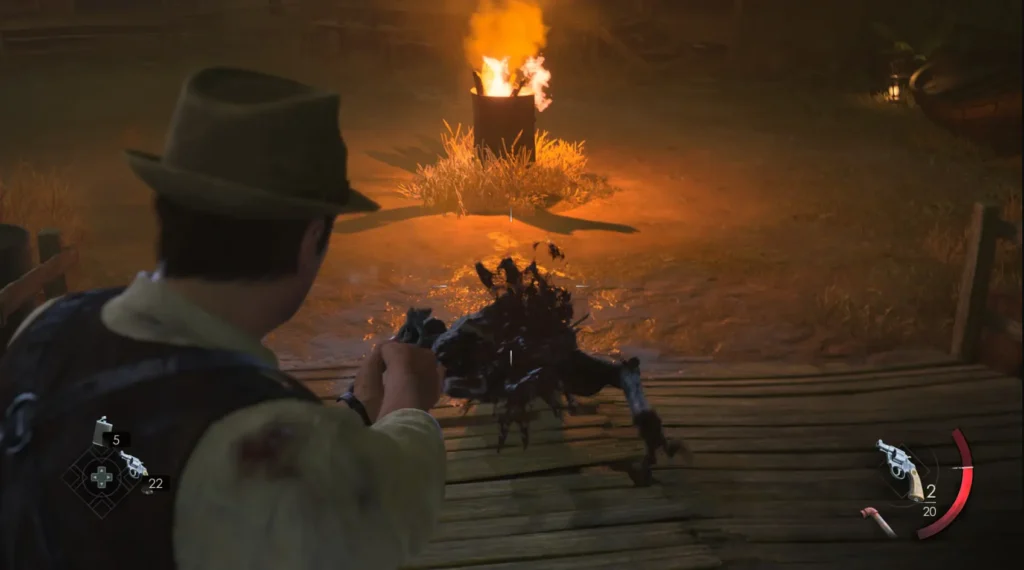
Even if it had been released in 2008, THQ Nordic’s Alone in the Dark would have suffered in comparison with Dead Space, due to the lack of accurate damage locations, imprecise combat, poor AI, and obvious minimal use of resources (few different weapons/enemies), for a game in 2024! Of course, it’s possible to move silently to avoid alarming all your opponents, but this doesn’t erase the limitations.
The general clumsy movement, the slow aiming mode when using projectiles, and the absence of a quick U-turn could be fatal if we weren’t faced with an old-fashioned Survival Horror. The genre has often relied on heroes in costumes to create a sense of fear in the player, even if it means causing harm. Still, we wish we hadn’t been blinded by scenery elements that get “stuck” between the camera and the character when aiming. It’s nice to use tight locations to generate suspense, but if you can’t see anything when you aim…
Hell Is Back Again
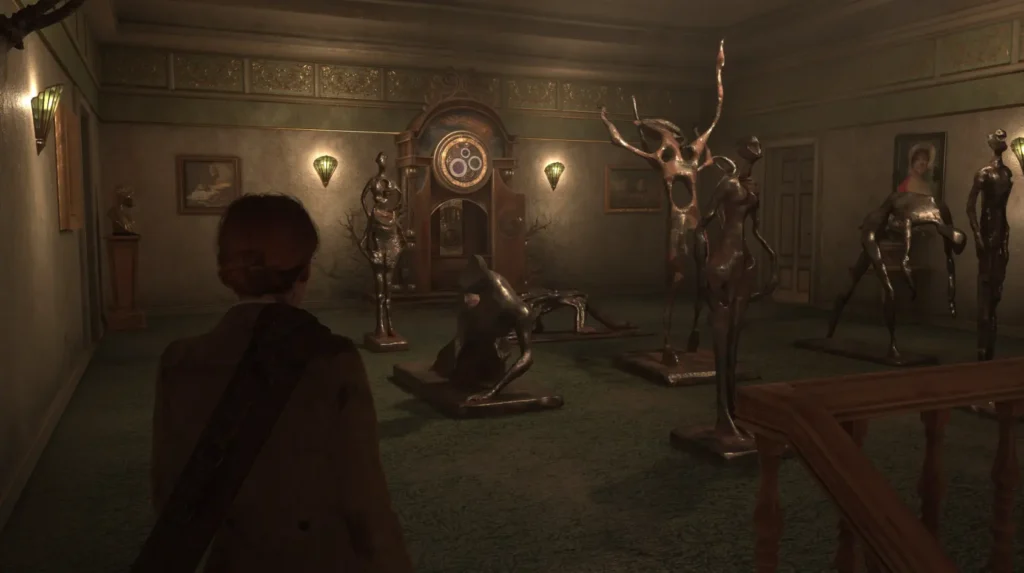
User experience issues are evident such as moss disfiguring the bark, with the hero represented by a dot instead of an arrow on the map (which hinders proper orientation), lying trunks/small ground elements impossible to jump over, and more generally inconsistent collisions. The numerous puzzles are a good indication of the dusty game design. The documents needed to solve the puzzles are found in a menu accessible by displaying the inventory, then finding the document, and finally finding the right page with LB/RB. When you’re in front of the puzzle you need to solve, there’s no quick view of the documents. If you want to look again at the pages of an important book, you’ll have to leave the puzzle window and repeat the same combination: Back, select document, LB/RB.
In certain areas, this new Alone in the Dark installment does even worse than its famous big brother from 1992, which tried – in its own way – to construct more systemic puzzles (a crate to be pushed over a trapdoor, a wardrobe to be placed in front of a window). A philosophy taken up by Eden’s opus, but one that Pieces Interactive has abandoned. Most of the time, the player has to find keys to open the building’s many doors and solve puzzles (literally, with pieces to be put in the right order). The slight originality lies in the use of a talisman, which, like the Conundrum in The Last Case of Benedict Fox, can be used to solve puzzles. We’d have expected more, even if it all fits nicely with the story.
On the positive side, the game does its best to ensure that the player doesn’t have to search the entire manor to find the solution to a problem. The difficulty can be customized at any time to make both combat and exploration easier/more challenging. Whether you like to rack your brains or not, you should never get stuck on a puzzle for too long… except for the Pregzt Company safe. This one is much more complex than the usual.
No, we won’t deny it, there’s an old-school feeling to THQ Nordic’s production that’s well worth appreciating, with a visit to a cemetery reminiscent of Nocturne, or wanderings through a misty town with hints of Silent Hill. More a Lovecraftian adventure game than an action-packed Survival Horror, this Alone in the Dark leans more towards Soma than Resident Evil. At least, that’s what we’d prefer to believe, to avoid a direct comparison with the Resident Evil 4 remake, which does better in almost every aspect.
More Like a Reunion Than a Revolution
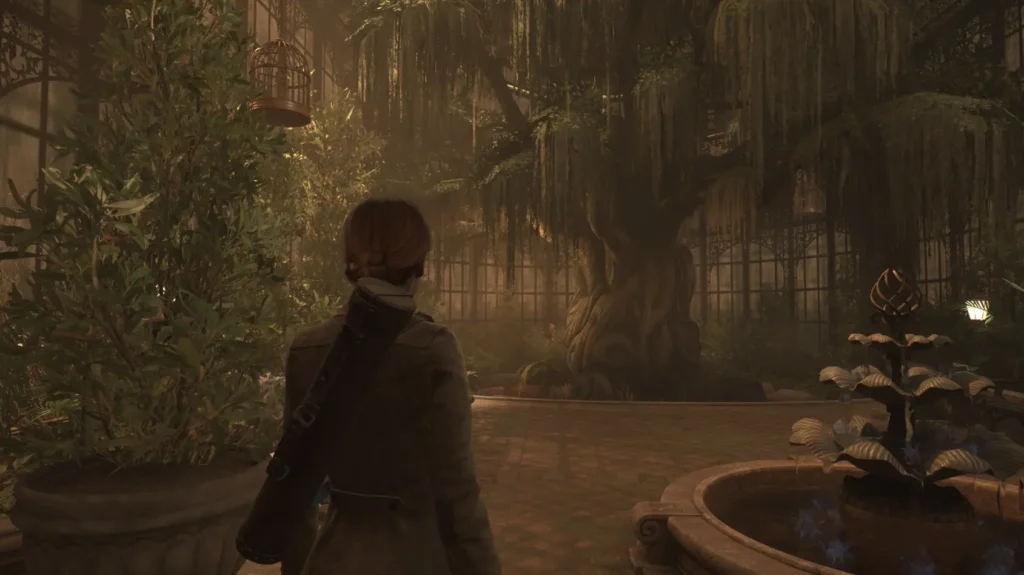
Alone in the Dark isn’t exactly stunning, but it does succeed in pleasing the eye with its brilliant art direction. The Italian architecture of Derceto, isolated in Louisiana, is truly impressive! The jazzy music contributes to the Lynchian madness present in every corridor of the mansion. For once, there’s no dry guitars, saturated percussion, and haunting synth strings. As for the special effects, they deserved more detail. Unfortunately, there are a few graphical and sound bugs to report, which have a negative impact on immersion. However, there are no scripting problems to be criticized, unlike the framerate drops that do occur at various points.
As you’ve probably understood by now, Alone in the Dark doesn’t try to reinvent the wheel in its gameplay mechanics or in the way it embraces Survival Horror, even if it means taking a rather worn rubber to turn Derceto’s wheels. But what about its narrative experience? Is its direction up to scratch? Is it scary? Who is it really for? Let’s be clear: despite what we may criticize in its gameplay and the lack of creativity in its puzzles, this Alone in the Dark is surely the finest tribute to the series in a very long time. An imperfect adventure in both form and content, but sincere in its approach.
Alone in the Dark has plenty to reveal, mainly through its two heroes, performed quite well by David Harbour and Jodie Comer, and also through other protagonists, which is something new compared to the 1992 experience. Edward and Emily aren’t really alone in the darkness this time, and the lost souls they meet in Derceto make for tasty dialogue.
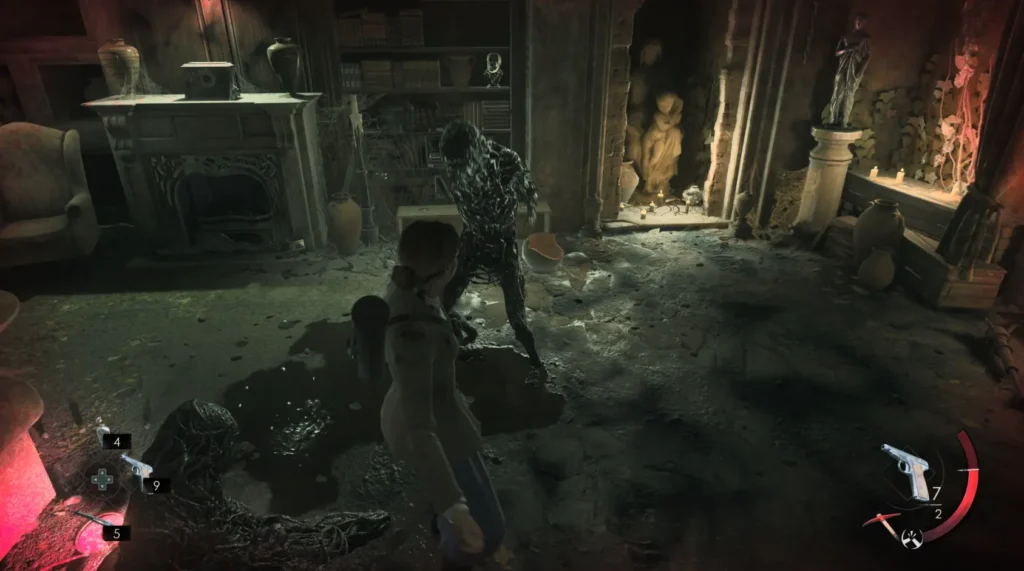
The scenario, intriguing in its initial moments, delivers some pleasant surprises, even allowing for a few meta delusions. From our point of view, this title is aimed primarily at fans of the first two installments (for content), or fans of old-fashioned horror adventure games (for form).
As we’ve already mentioned, Pieces Interactive’s production knows how to play with fans’ expectations (will the attic open? will it not?) while scattering a few subtle nods to previous installments (the names of the Infogrames dream team here, famous objects/creatures/music there). But it goes further than we might have expected. In many ways, Alone in the Dark is more than just a revision of the first trilogy.
If you want all the keys to Derceto Manor, you’ll have to delve into the real books. The ones that tell the story of the mad adventure of a small group of people who, in 1992, brought Edward Carnby and 3D survival horror to life by killing Jeremy Hartwood.
Conclusion
Alone in the Dark 2024 is an old-fashioned Lovecraftian action-adventure game more than it is a thrilling Survival Horror, with an interesting re-imagining of the original episodes. Unfortunately, nostalgia stumbles upon obsolescence: even the hardcore fan of the license will find it hard to ignore the outdated systems. We would have liked to see Pieces Interactive’s title, freed from the chains of big-budget AAAs and the need to outperform its competitors, try more things, do things differently, and allow itself a certain radicalism.
